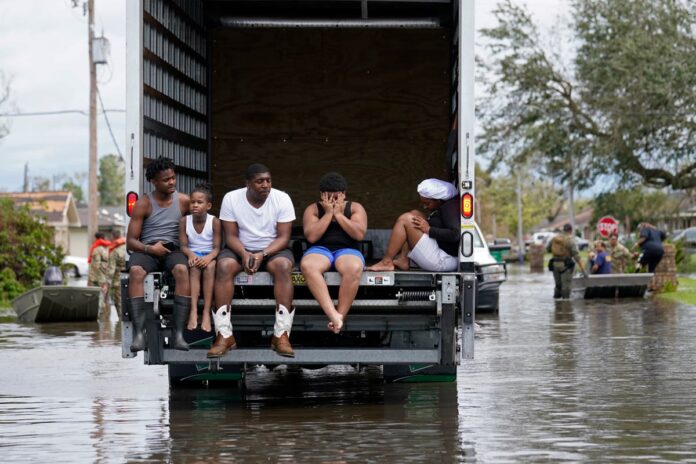EDITORS/NEWS DIRECTORS:Ninety percent of the counties in the United States suffered a weather disaster between 2011 and 2021, according to a report published Wednesday.Some counties endured as many as 12 federally-declared disasters over those 11 years. More than 300 million people – 93% of the country’s population – live in these counties.Rebuild by Design, which published the report, is a nonprofit that researches ways to prepare for and adapt to climate change. It was started by the Department of Housing and Urban Development in the wake of Hurricane Sandy, the catastrophic storm that slammed into the eastern U.S. just over ten years ago, causing $62.5 billion in damage.Researchers had access to data from contractors who work closely with the Federal Emergency Management Agency, allowing them to analyze disasters and payouts down to the county level. The report includes some 250 maps. They also looked at who is most vulnerable, and compared how long people in different places are left without power after extreme weather. Read the AP’s story: 90% of US counties hit with disaster in last decade, report saysWHERE TO FIND THE LOCAL DATA- Reporters can find out how many weather disasters have hit their states and counties, how much money has been spent by the federal government on disaster relief and more using the website created for Rebuild by Design’s report: https://www.rebuildbydesign.org/atlas-of-disaster/- Scroll down the website landing page to select a state and county view from any of the 50 states. The data show every major storm or extreme weather event and how much money was paid out. WHAT ARE SOME KEY QUESTIONS?- How do different states rank against each other in terms of federally declared disasters and federal dollars spent per person in disaster relief? Did neighboring states have as many disasters and, if so, did they receive as much money?- Where do the most vulnerable residents live in your state and how much in federal disaster funding did they receive? Why do they receive as much relief funding as they do?- How long are communities left without power during an extreme weather event? What are the public utilities in your state doing to ensure equitable access to power, even during extreme weather events? Are those the same communities that are the most vulnerable?- What kinds of disasters hit different counties in your state between 2011-2021? Do they differ by region of your state? – Does your state endure heat waves and rank low in terms of federal disaster relief spending? Why does the federal disaster law exclude heat waves?- How does climate change affect weather disasters happening in your state and county? How can your state and county prepare for weather disasters that may be worsening due to climate change?PUBLISHABLE CONTEXTIn the report, the authors attribute every weather disaster to climate change, which is inaccurate. Climate change has turbocharged the climate and made some hurricanes stronger and disaster more frequent, said Rob Jackson, a climate scientist at Stanford University. But ‘I don’t think it’s appropriate to call every every disaster we’ve experienced in the last 40 years a climate disaster.’Even though all the weather disasters compiled aren’t attributable to climate change, Jackson said the collection could still have value.’I do think there is a service to highlighting that weather disasters affect essentially all Americans now, no matter where we live.’He noted that federal spending on disasters has skyrocketed in recent years, to at least $100 billion a year. In 2021, the total was $152 billion.The National Centers for Environmental Information estimate over $1 trillion was spent on weather and climate events between 2011 and 2021. Over the last five years, from 2017-2021, $788 billion was spent on weather and climate events. In the report, Rebuild by Design recommends the federal government shift to preventing disasters rather than waiting for events to happen. It cites the National Institute of Building Sciences which says that every dollar invested in mitigating natural disaster by building levees or doing prescribed burns saves the country $6.’The key takeaway for us is that our government continues to invest in places that have already suffered instead of investing in the areas with the highest social and physical vulnerability,’ said Amy Chester, managing director of Rebuild by Design and one of the report co-authors.POTENTIAL SOURCES- Amy Chester, one of the study authors and managing director of Rebuild by Design: achester@rebuildbydesign.org- The data partners for Rebuild by Design on this report, Paul Tschirsky at APTIM (Paul.Tschirky@APTIM.com), and Jeff Stevens at iParametrics (Jeff.Stevens@iparametrics.com)- Climate scientists can be valuable in contextualizing the report findings and differentiating climate and weather. Here are a few to reach out to:1. Rob Jackson, climate scientist at Stanford University – Rob.Jackson@stanford.edu2. Gabe Vecchi, climate scientist at Princeton University – gvecchi@princeton.edu3. Adrienne L. Hollis, climate and environmental justice expert at George Washington University – alhollis81@gwu.edu4. Robert Bullard, climate and environmental justice expert at Texas Southern University – robert.bullard@tsu.edu5. David Archer, climate scientist at the University of Chicago – meredithdavis@uchicago.edu- The National Centers of Environmental Information can be valuable in quickly accessing government spending on weather disasters: https://www.ncei.noaa.gov/access/billions/- National Integrated Heat Health Information System has several tools that can be helpful in telling the story of heat in your states, counties and cities: https://www.heat.gov/pages/tools-information___Localize It is an occasional feature produced by The Associated Press for its customers’ use. Questions can be directed to Katie Oyan at koyan@ap.org.


